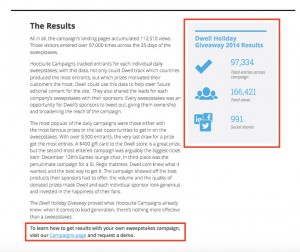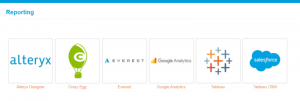Are you using your analytics data incorrectly? Contributor Jacob Baadsgaard explains why you need to track and review traffic, conversions and sales to make smart marketing decisions.
 One of online marketing’s claims to fame is the fact that you can track almost everything.
One of online marketing’s claims to fame is the fact that you can track almost everything.
Send out an ad in the mail, and you have little to no idea how many people tossed the ad without looking at it, let alone how many consumers came to your store as a result of seeing your ad. Same goes for billboards, radio spots, television ads.
But online marketing? With online marketing, you can track everything!
You can know exactly how many people saw your ad, how many responded to your content, how many converted on your site, and even how much revenue came from that ad.

Pretty amazing, right? With data like that, it seems like every online marketing campaign should be running at optimum profitability.
Only, that doesn’t seem to be the case.
In fact, it’s believed that 60 percent of all online advertising spend is wasted. But how? I mean, with all that data, how could that much ad spend be wasted?
Is our analytics data lying to us?
Well, data doesn’t lie, but it is often misused and misinterpreted. So, even if you’ve got a great analytics setup in place, if you aren’t using your data correctly, you can end up wasting a ton of money and opportunity.
With that in mind, let’s take a look at how you can use data to make smart online marketing decisions in three areas: traffic, conversions and sales.
1. Traffic
There’s a lot of value in understanding just how appealing your marketing is to your potential audience. This is where traffic-focused metrics come into play.
If you’re operating a pay-per-click campaign, cost-per-click (CPC) and click-through rate metrics can tell you a lot about what ads, headlines or descriptions are really catching the eyes of your audience.
For instance, in AdWords you have traffic statistics like impression share, keyword performance and device segmentation. These can give you a ton of insight into how your audience is interacting with your ads.
As an example, let’s say that you’re marketing for a law firm that averages $3,500 in revenue from each new paying customer, and you have a profit margin of 50 percent.
Your online marketing campaigns look like this:

By looking at this data, you can see pretty clearly that Campaign 3 has the lowest CPC, the best click-through-rate (CTR) and the most clicks. By comparison, Campaign 4’s CPC is almost 10x higher than Campaign 3’s CPC!
But before you get too excited, remember, clicks do not equal revenue.
Traffic data tells you whether or not your audience is responding to your ads, but it doesn’t tell you whether they are the right traffic for your site. To get at that data, you need to know whether your traffic is actually converting.
2. Conversions
Where traffic data tells you about how people respond to your marketing, conversion metrics show you how well your site meets their needs and expectations.
Essentially, conversion data helps answer two different, but related questions:
1. Is your site right for your traffic?
If a fair percentage of your traffic is converting (e.g., by submitting forms, calling in), that means your landing page and site are a pretty good match for your traffic.
Conversely, if your traffic isn’t converting, something about your landing page/site has something going on that probably isn’t working for your audience. Maybe there are too many options, too-long forms, excessively long content, distracting elements or any number of other issues.
Conversion rate optimization (CRO) is all about fixing these sorts of problems. So, if you’re getting lots of traffic but it’s not converting, try changing (or even getting rid of) a few elements of your site.
2. Is your traffic right for your site?
It’s natural to assume that when traffic doesn’t convert, something is wrong with your site. After all, people clicked, so the problem must be the site!
Unfortunately, that’s often not the case. The wrong kind of traffic won’t convert — no matter how great your site might be.
If your conversion metrics aren’t looking that great, it’s often most effective to start by taking a look at your traffic. Does your marketing clearly indicate what awaits your users after a click? Are you targeting the right audience? Or does your keyword, audience or demographics targeting cover an overly broad group of people?
If the answer to any of these questions is “yes,” your traffic may be a bigger problem than your user experience. Try optimizing your traffic quality and see if your conversion rate improves.
What conversion metrics can tell you
The key to optimizing your conversion rates is to make sure that you are sending the right traffic to the right page. Otherwise, you might end up wasting a lot of money on clicks that never convert.
For example, let’s take another look at our hypothetical law firm example:

Although Campaign 3’s conversion rate (CR) isn’t very good, its CPC was low enough that its cost per lead (CPL) still beats out all of the other campaigns. Possibly for the same reasons, Campaign 4’s CPL is still in last place.
Still, Campaign 3 has a conversion rate that’s only half as good as Campaign 1’s, so it could probably use some improvement. Perhaps there’s a portion of the traffic that sees the site as irrelevant, or maybe the campaign sends traffic to a poorly converting landing page.
In either case, the conversion data indicates that there is clear room for improvement.
3. Sales
Now, traffic and conversion data is important, but neither of these metrics answers your most important business question: Are my campaigns profitable?
The goal of any marketing campaign is to bring in revenue for the company. To really understand if your campaigns are doing that, you need to track your campaigns’ effectiveness all the way from click to close.
Let’s go back to our law firm example:

Remember, up ’til now, Campaign 3 has been our clear winner, and Campaign 4 has been our biggest loser. However, when it comes to return on investment (ROI), Campaign 4 is the hands-down winner.
What happened?
As it turns out, Campaign 4 — despite its high CPC and low CR — actually has a high sales rate (SR). Over 3 percent of Campaign 4’s leads turn into paying clients.
In comparison, just 0.2 percent of Campaign 3’s leads become paying clients. That drops Campaign 3’s ROI and cost per sale (CPS) into dead last. And since the firm only has a profit margin of 50 percent, it’s actually losing money on this campaign.
Now, there are lots of reasons why Campaign 4 could have been losing in terms of traffic and conversion metrics while still being the most profitable campaign. Maybe the traffic it’s getting is lower in the sales funnel (leading to a higher cost per click and fewer clicks). Perhaps Campaign 4 filters leads better at its landing page, leading to a lower conversion rate.
Whatever the reason for Campaign 4’s profitability, this isn’t an uncommon scenario. I’ve seen results like this for all sorts of companies.
However, most online marketers don’t take the time to look at how their campaigns, targeting and ads are performing in terms of sales. As a result, they end up optimizing for their own “Campaign 3s” — campaigns that look good in terms of traffic or conversions but are ultimately unprofitable for their business.
Is their analytics data lying to them? No, but because they aren’t using their analytics data properly, it sure might look like it!
Conclusion
When it comes to marketing, what you don’t know can hurt you.
Analytics is one of the most wonderful things about online marketing, but if you aren’t tracking and reviewing campaign performance at the traffic, conversions and sales levels, you’re shooting yourself in the foot.
So, are you using your analytics data correctly? Or are you lying to yourself?
Some opinions expressed in this article may be those of a guest author and not necessarily Marketing Land. Staff authors are listed here.
Marketing Land – Internet Marketing News, Strategies & Tips
(53)









